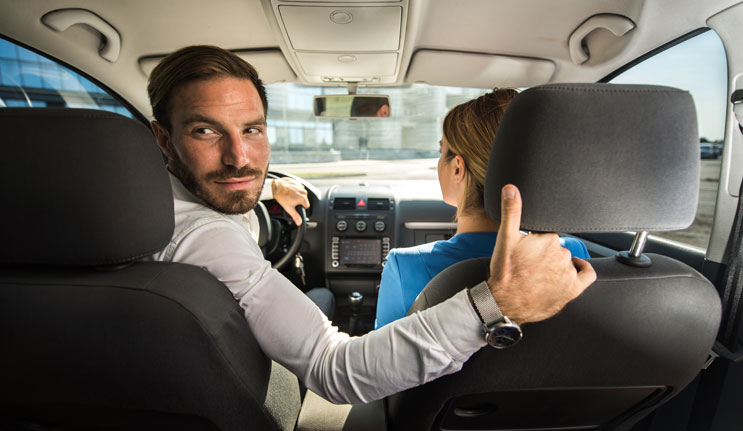It’s no secret that many drivers have trouble reversing their vehicle. Many times, it’s either their own lack of mobility or the feeling that nothing bad will really happen while driving in reverse. Regardless of the reason, collisions do occur when backing, but that can easily change. One of the things to realize is, whether you back up into or out of a driveway or parking space, there is risk. You may not be able to eliminate all of the risk, but you can certainly reduce it.
Vehicle Blind Spots
Part of the issue of reversing is the fact your vehicle suffers from blind spots around each side of the vehicle, which makes it difficult to see vehicles, people and objects from the driver’s vantage point. The rear area on passenger vehicles has a blind spot area anywhere from 20 to 50 feet. Although that may sound unrealistic, it’s true. The higher the trunk lid, the more it hides from the view of the driver. The shorter the driver sits in the seat, the more it affects what the driver can see as well.
Most people will pull forward into their parking space or driveway and then back out of it. As common as that may seem, it’s not the safest parking decision. Backing into an aisle or onto a street means the driver needs to constantly look over each shoulder to see approaching vehicles from two different directions. Since many drivers tend to trust other drivers to do the proper thing and give the needed space, they tend to reduce how many times they check for approaching traffic or pedestrians. This adds to the risk of backing out of driveways or parking spaces. Backing into a parking space is far easier and safer because there are fewer moving variables to address.
If you decide to back into a parking spot, the best approach is to glance into the parking space as you pass by it slowly to ensure you’re aware of any objects which may still be in that space. Backing up blindly may result in you colliding with an object occupying the parking space or another vehicle failing to see you backing up. However, starting from 2018, all new vehicles sold in the US now must have a backup camera. The backup camera can help to make reversing easier and safer, but there are a few things to consider before relying on one.
r
Vehicle Backup Cameras
The first thing to consider if you’re going to use a backup camera is the camera’s field of view. Most new backup cameras have a wide view which can assist the driver in identifying potential risks approaching from the rear but also from the side of the vehicle, such as pedestrians. However, if the backup camera on your vehicle has a smaller, narrower view, you should also take a few glances around your vehicle while you’re backing up. With so many distracted pedestrians these days, some people may be clueless to what’s happening in their proximity that they may walk directly behind your vehicle while you’re reversing. So now the question again: should you back into the parking space or driveway or should you back out of the parking space or driveway? My vote is to back into the space as it can be done quite easily and safely.
To begin, after passing the desired parking space and verifying that there are no obstructions, position your vehicle 90 degrees from the row of parked vehicles (or in the case of your driveway, parallel with the edge of the road). Although many drivers may angle their vehicle across the parking lot aisle, that can block all other traffic from getting past you while you’re attempting to park. Remaining at a 90-degree angle allows for traffic to pass while you’re waiting for it to be clear to proceed. Plus, it streamlines the parking process.
Keep Your Fleet Drivers Safe on the Road with These eLearning Courses on Distracted Driving:
How to Back Into a Parking Space
I’ve watched many drivers over the years attempt to back into a parking space—over and over again—but with little success. Here’s the quick and easy way to be successful. As you pass the empty parking space, position your vehicle so it’s one vehicle width away from the end of the space and the rear of your vehicle is one parking space in length past your intended parking spot. This is the minimum amount of space needed to successfully back into a parking space. Parking beside another parked vehicle also makes backing into a space easier because the parked vehicle is easier to spot than the painted lines on the ground.
After checking all around your vehicle for pedestrians, cyclists or other moving vehicles, begin slowly moving your vehicle in reverse, steering toward your space. If you’re having a difficult time seeing over your shoulder while your seat belt is on, many jurisdictions allow you to remove it while backing up. However, once you’ve stopped backing up, always put your seat belt back on. If you have a vehicle parked next to your intended space, steer enough to appear that you’re getting very close to that parked vehicle. It may look too close at first, but by getting close to that parked vehicle as you begin to steer, you’ll end up in the middle of the parking space when you’ve finished parking. Once your vehicle is almost straightly aligned within the parking space, begin to quickly straighten the front wheels.
Backing up your vehicle can become simple to do with some practice. Realizing the view behind the vehicle isn’t as good as the view in the front is a major first step. Always take your time while backing up to ensure you’re aware of your surroundings while keeping the speed of your vehicle like that of walking. That will give you time to adjust your steering if you’re a little off with your position or if you spot a distracted pedestrian. Good luck and drive safely!
About the Author

Scott Marshall has spent over 30 years promoting road safety. He has been a road safety journalist since 2005. Scott was also an on-air judge on the Discovery Network’s Canada’s Worst Driver during its first three seasons. Scott welcomes any questions or comments you may have at safedriver36@yahoo.ca.
Keep your employees safe at work with these training courses on fleet safety:
Speeding Awareness – Large Vehicles



